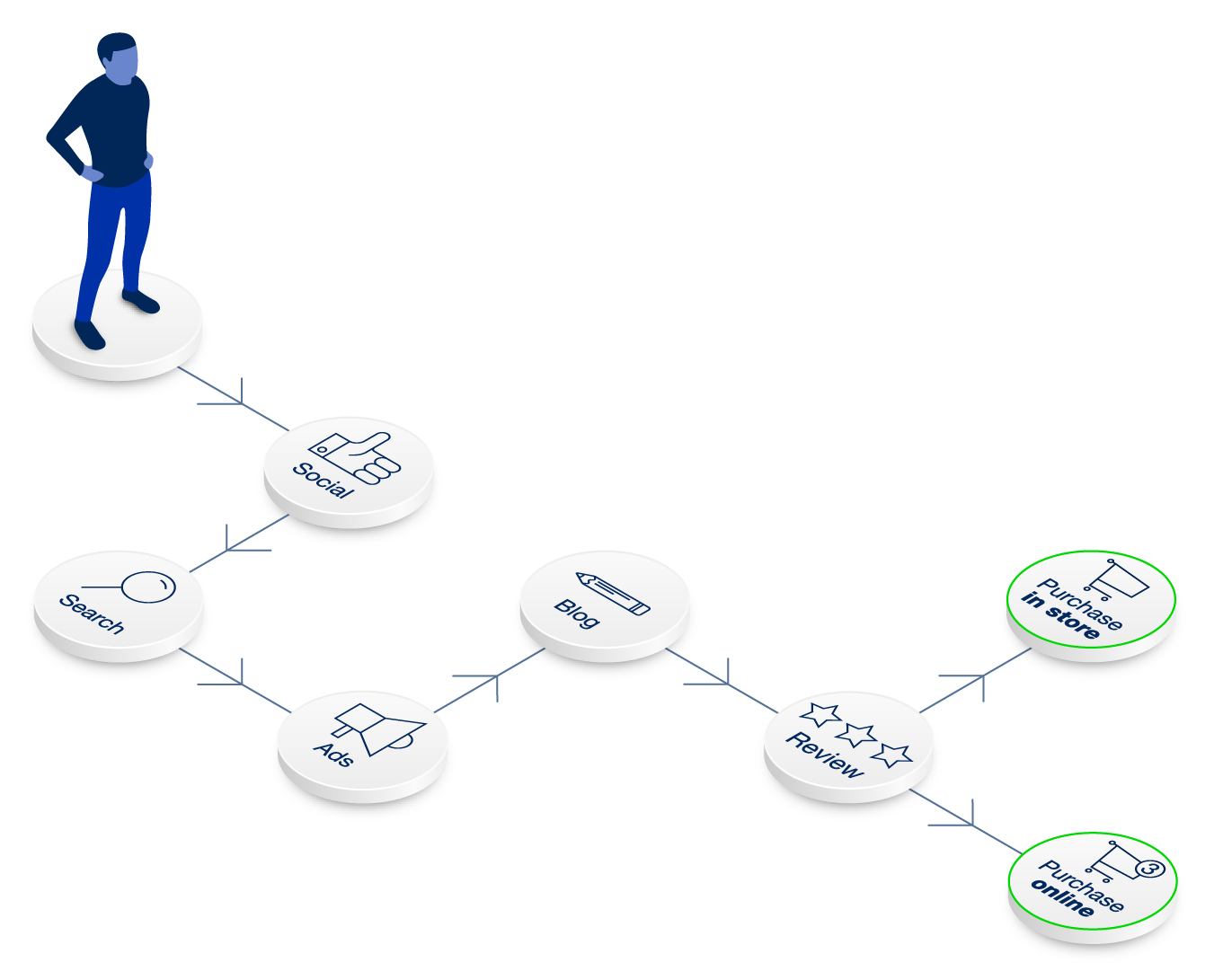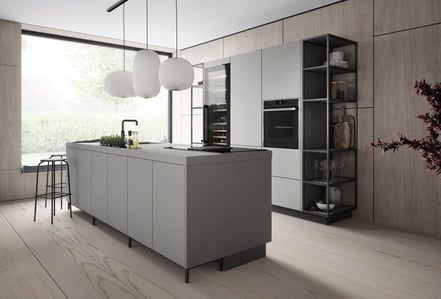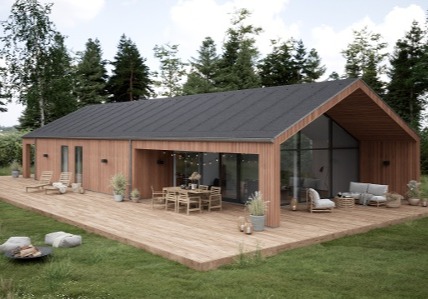E-commerce businesses, and businesses with both a brick and mortar and an e-commerce presence, have seen online sales rise exponentially during the past decade. Global e-commerce sales topped $4.2 trillion in 2020, and are expected to exceed $6.5 trillion by 2023 [I]. Part of the huge growth in online transactions can of course be attributed to the Covid-19 pandemic. Online shopping became the norm for both individuals and many B2B organizations.
Subsequently, many brands also had to adapt to the change in consumer needs and expectations. More attention was placed on marketing to an online audience, with a strong focus leaning towards improving the customer experience. Brands have realized that in order to remain competitive, they must deliver outstanding CX that sets them apart from their competitors and improves brand recognition and loyalty. One way many brands have achieved this is through the use of a product configurator.
6 BUZZWORDS shaping RETAIL IN 2022
- Digitalization
- Physical restrictions
- Self-service
- Explosion of choice
- Personalization
- Gamification
Trends shaping online and offline retail in the upcoming year
There are new trends emerging in the upcoming years shaped by the global pandemic and expectations of increased digitalization. What are the exact areas you should be aware of?
- Digitalization – more and more consumers expect to interact with brands and products through digital media.
- Physical restrictions – customers have fewer opportunities to interact with brands physically while the pandemic disrupts travel and access to stores.
- Self-service – consumers are comfortable doing their own online research – autonomously and without having to interact with shop staff.
- The explosion of choice – high expectations regarding choice and multiple options can trouble customers who also expect simple navigation and guidance.
- Personalization – according to the report by Deloitte, consumers are willing to pay 20% more for a personalized product [II].
- Gamification – customers can ‘play’ at being a product designer, with rewards for completing a configuration.
What is a product configurator?
A product configurator, also referred to as product configuration software is a very useful tool that enables a business to put together a 3D representation of a product according to a client or customer’s unique specifications. For example, if someone wanted to see what a model of their new kitchen might look like, a designer would use a kitchen configuration tool to automate the process and showcase a 3D model of the kitchen.
The customer could then view the model from all angles, zoom in or out, and request changes as necessary, which could be easily and quickly performed using the product configuration software. Other product configuration examples include clothing shops that enable customers to design their own t-shirt or a furniture company that lets customers design a sofa. In either example, customers might choose certain attributes, such as size, color, sleeve length for the shirts, or cushion style for the sofa.
Originally, product configuration was used primarily in the manufacturing industry. But as more brands in a variety of industries realized the benefits of using product configuration for e-commerce, it has come to play a much larger role in the realm of online shopping.
The benefits of a product configurator
One of the best ways an e-business can help a customer is to allow the customer to help themselves, all while improving the customer journey and facilitating a purchase. Product configuration is an ideal tool for just such a purpose, serving to guide the customer along their journey without being unnecessarily intrusive. The best product configurators deliver a range of benefits to both the consumer and the e-commerce business.
1. Product configuration can be used to present and sell complex products
Many complex products that are more suited for B2B transactions often contain a host of features and options or require many calculations to be performed before a model can be properly created and displayed. Product configuration software enables clients or customers to easily put together models simply by selecting the features and options they desire. Such an intuitive and advanced process is highly preferred, and, of course, much more convenient than checking off a bunch of options in a catalog without being able to actually visualize the completed product.
And, with presets for each product, there is improved accuracy that ensures a customer cannot select features or options that are incompatible with one another. The product configuration software will alert the customer if an option cannot be selected.
2. Improved quote and pricing accuracy
Preparing quotes used to be a time-consuming task. The client or customer would need to relay what they want to your sales team, which would then need time to prepare the quote and return it to the client. With a product configuration website built into your e-commerce site, when a customer submits an order, they can receive a quote immediately. This saves your sales team a great deal of time and ensures that pricing is accurate. This also frees up time for your sales team to assist other customers that might require more assistance.
3. Manufacturing receives the correct information
Human error can never be completely eradicated. When working with manual submissions of specs and materials, mistakes can be made. And sometimes, the product then gets made incorrectly before anyone realizes the error. This costs your business time and money and also results in an unhappy customer. But with a product configurator putting together the order for you, this problem is solved. In fact, you could even call it a solutions configurator.
The product configurator can even alert the client that some materials might not be available before completing the order, or, it won’t even offer the option at all if some materials aren’t in the current available inventory. Manufacturing receives the correct order directly from the product configuration software. The product gets made correctly, and everyone is happy.
4. Product configuration improves your marketing efforts
There’s less need for your marketing department to spend time attempting to showcase your products to the target audience because your customers will likely already be doing it for you. When a customer creates their product on your product configuration website, they become invested in their creation. Many customers will then choose to share their custom product on social media, expanding your marketing reach without the need for additional marketing spend. And why would they do that? Simply because configurators are highly engaging, educational, and fun.
Meanwhile, the customer is pleased. Their quote time got cut from weeks to minutes. And the online self-service process freed your product experts to take care of more critical issues than helping customers go back and forth on configuration options. This builds trust with the customers and is getting them closer.
5. Product configuration meets customer expectations
Today’s consumers expect a lot. They want to be able to find the information they seek quickly, and they certainly don’t want to have to spend time talking with customer service or a sales representative if they don’t have to. Product configuration solves these pain points by offering customers speed, independence, and the flexibility to create custom products easily. The intuitive product configuration software enables customers to quickly design and order their desired product, improving both brand recognition and brand loyalty.
A pain point of online shopping is the lost ability to touch and review the product in person. This can be partially aided by the 360-degree viewer replicating the in-store experience. Plus customers can save their configuration and pick up where they left off.
You might also like: "The best online configurators that increase your sales."
Why do you need a product configurator?
The aid of such a special tool is essential to streamlining efficiency and improving customer loyalty. It serves to impact the speed at which orders can be processed and proposals and contracts can be written. Your product designers can design rules and constraints for the product configuration software, helping it to grow and become more powerful over time so that it can always offer the ideal solution for your customers.
And, chances are, your competitors may already be using a product configurator. Many brands in a multitude of industries have already realized that CX is a critical component to brand success. Subsequently, they have sought the means to meet and exceed higher customer expectations, and turn leads into customers.
Product configuration software sounds difficult, but it is actually an easy-to-use marketing tool that allows you to showcase your full product range along with the value of your products. It is likely to become a primary solution for attracting, engaging, and retaining customers.

Product configuration and the customer journey
With a product configuration website, it is easy for customers to see their ideas become reality. Producing a visual concept of the client’s selections delivers a great customer experience, especially when complex products are involved. There is no interruption to the customer journey due to delays in design or mistakes made in inventory.
This makes it easier than ever for your customers to purchase products from your brand. Customers will also appreciate the photorealistic 3D quality of the presented products, reassuring them that what they see is what they will get. It’s a win-win – your customers have fun with your product and your brand, they are reassured and proud of their customized solution, and your sales representatives will spend less time per customer as they all come well-prepared.
You might also like: "What is the eCommerce customer journey your customers will love?"
Sources
[II] https://www2.deloitte.com/content/dam/Deloitte/ch/Documents/consumer-business/ch-en-consumer-business-made-to-order-consumer-review.pdf















